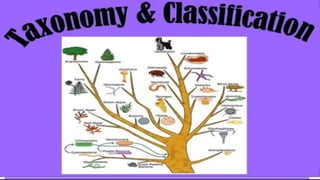
Biological Classification
- 3. BIOLOGICAL CLASSIFICATION OF ANIMALS AND PLANTS Biological classification of plants and animals was first proposed by Aristotle on the basis of simple morphological characters. Morphological Characteristics – refers to the shape, size, colors and etc. Specific parts.
- 4. BIOLOGICAL CLASSIFICATION OF ANIMALS AND PLANTS Carolus Linnaeus/ Carl von Linne, A Swedish Botanist - reclassified all living organisms into two kingdoms – Plantae and Animalia. Father of Taxonomy
- 5. Robert Whittaker proposed an elaborate five kingdom classification – Monera, Protista, Fungi, Plantae and Animalia.
- 6. BIOLOGICAL CLASSIFICATION OF ANIMALS AND PLANTS The main criteria of the five kingdom classification were cell structure, body organization, mode of nutrition and reproduction, and phylogenetic relationships [evolutionary development and diversification of a species].
- 7. BIOLOGICAL CLASSIFICATION OF ANIMALS AND PLANTS At present, the biological classification includes: 1. Kingdom Monera 2. Kingdom Protista 3. Kingdom Fungi 4. Kingdom Plantae 5. Kingdom Animalia 6. Viruses, Viroids and Lichens
- 9. In the five-kingdom classification, bacteria are included in Kingdom Monera. Kingdom Protista includes all single-celled eukaryotes such as Chrysophytes, Dinoflagellates, Euglenoids, Slime-moulds and Protozoans. Members of Kingdom Fungi show a great diversity in structures and habitat. Most fungi are saprophytic in their mode of nutrition.
- 10. The plantae include all eukaryotic chlorophyll-containing organisms. Algae, bryophytes, pteridophytes, gymnosperms and angiosperms are included in this group. The heterotrophic eukaryotic, multicellular organisms lacking a cell wall are included in the Kingdom Animalia.
- 11. • Some acellular organisms like viruses and viroid's as well as the lichens are not included in the five kingdom system of classification. • Acellular organisms – Organism that are not made up of cells of divided into cells. “Cell Free” organisms.
- 12. • Further classification is done by naming the sub- groups at various levels as given in the following scheme: KPC OF GS 1.Kingdom, 2.Phylum (For Animals) / Division (For Plants), 3.Class, 4.Order, 5.Family, 6.Genus, 7.Species.
- 14. KINGDOM MONERA • THE ORGANISMS IN THIS GROUP ARE 1.PROKARYOTIC 2.UNICELLULAR 3.MOST ABUNDANT MICRO-ORGANISMS AND LIVE IN EXTREME HABITATS
- 15. KINGDOM MONERA • MODE OF NUTRITION 1.AUTOTROPHIC - SYNTHESIZE THEIR OWN FOOD 2.HETEROTROPHIC - GETTING FOOD FROM THE ENVIRONMENT • STRUCTURE 1.BACTERIA - WITH CELL WALL 2.MYCOPLASMA – WITHOUT CELL WALL
- 16. BACTERIA ARE GROUPED UNDER FOUR CATEGORIES BASED ON THEIR SHAPE 1. THE SPHERICAL COCCUS 2. THE ROD-SHAPED BACILLUS 3. THE COMMA SHAPED VIBRIUM 4. THE SPIRAL SPIRILLUM
- 22. KINGDOM PROTISTA • Organisms Under This Group are all single-celled eukaryotes. • Their mode of nutrition can be autotrophic or heterotrophic. • Members of Protista are primarily aquatic. Some have flagella or cilia that helps in movement. • Protists reproduce asexually and sexually by a process involving cell fusion and zygote formation.
- 23. KINGDOM PROTISTA
- 31. Kingdom Fungi • These are heterotrophic eukaryotic organisms • Most fungi are heterotrophic and absorb soluble organic matter from dead substrates and hence are called saprophytes • Those that depend on living plants and animals are called parasites • Reproduction in fungi can take place by vegetative means – fragmentation, fission and budding. • Asexual reproduction is by spores called conidia or
- 32. Kingdom Fungi Many of fungi have the capacity to become multicellular organisms at certain stages in their lives. They have cell-walls made of a tough complex sugar called chitin. Fungi are cosmopolitan They prefer to grow in warm and humid places. With the exception of yeasts which are unicellular, fungi are filamentous. Some are the source of antibiotics, e.g., Penicillium.
- 33. Kingdom Fungi
- 34. Kingdom Fungi
